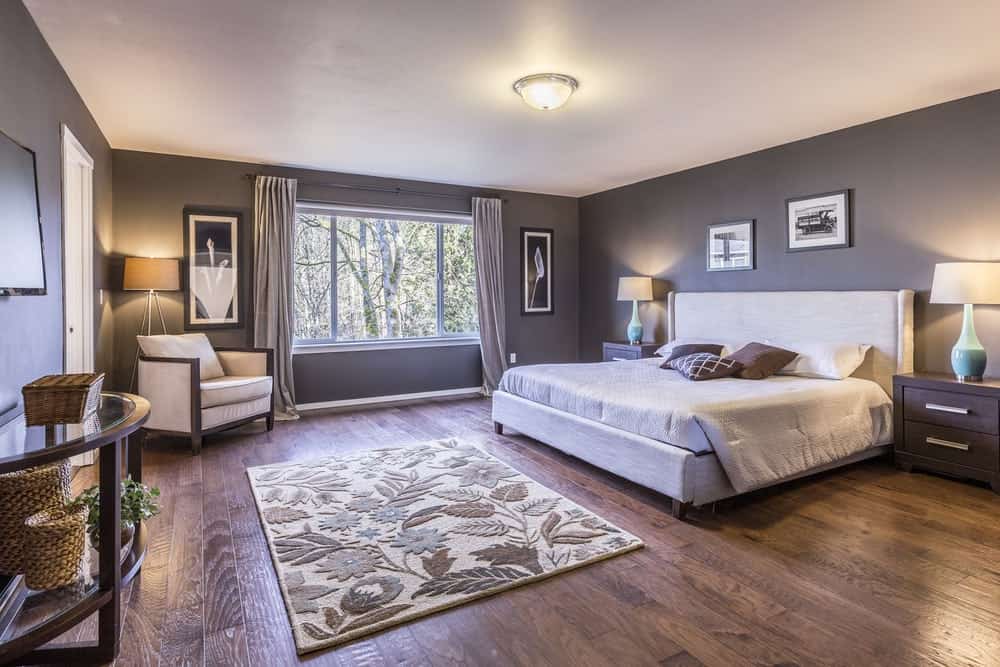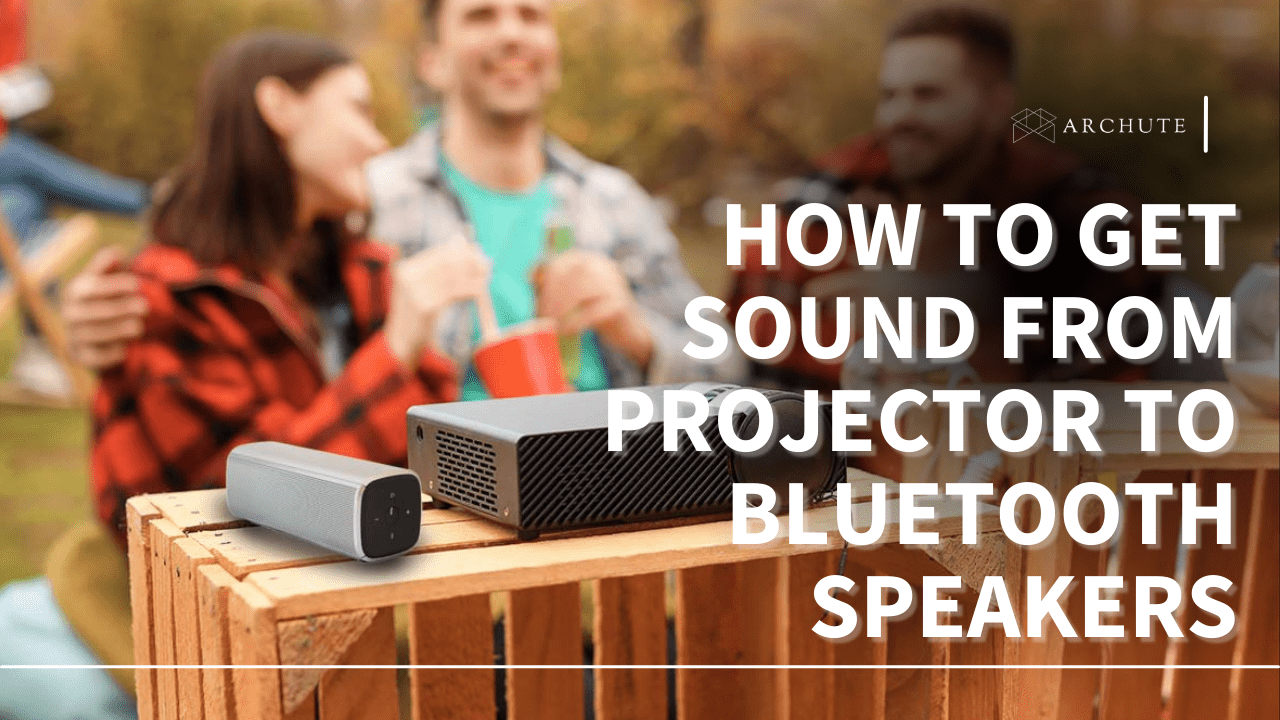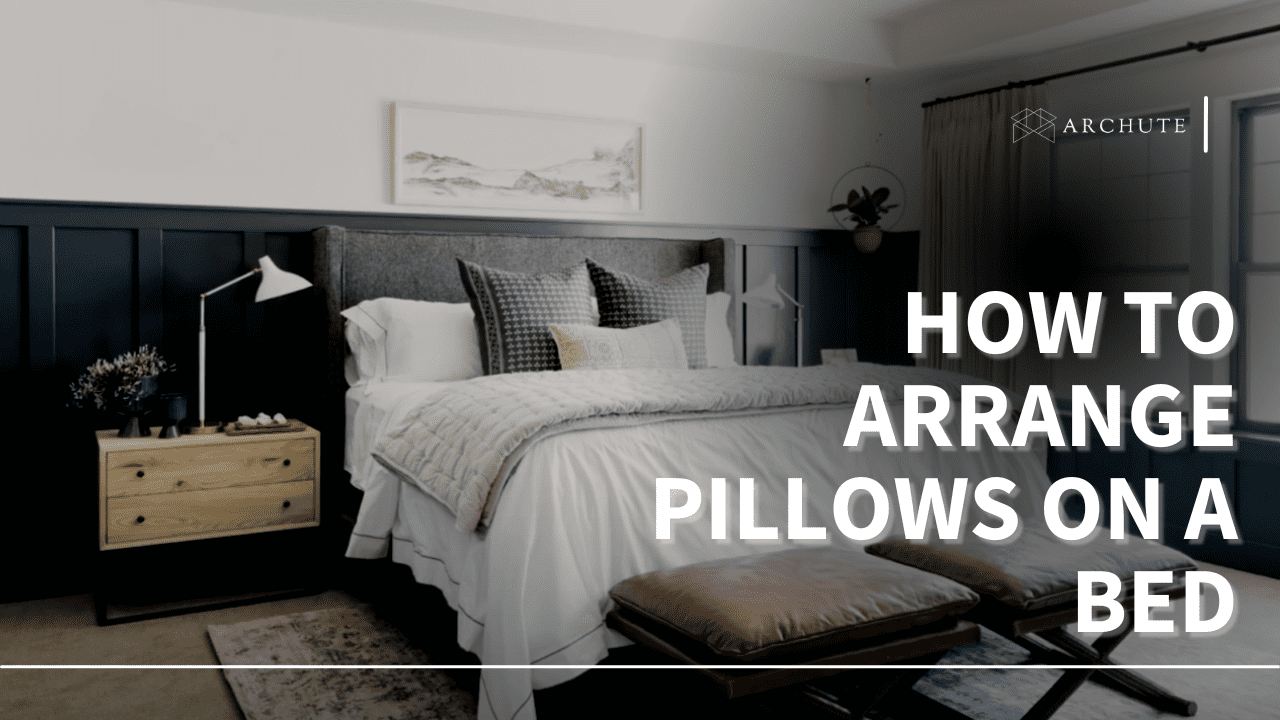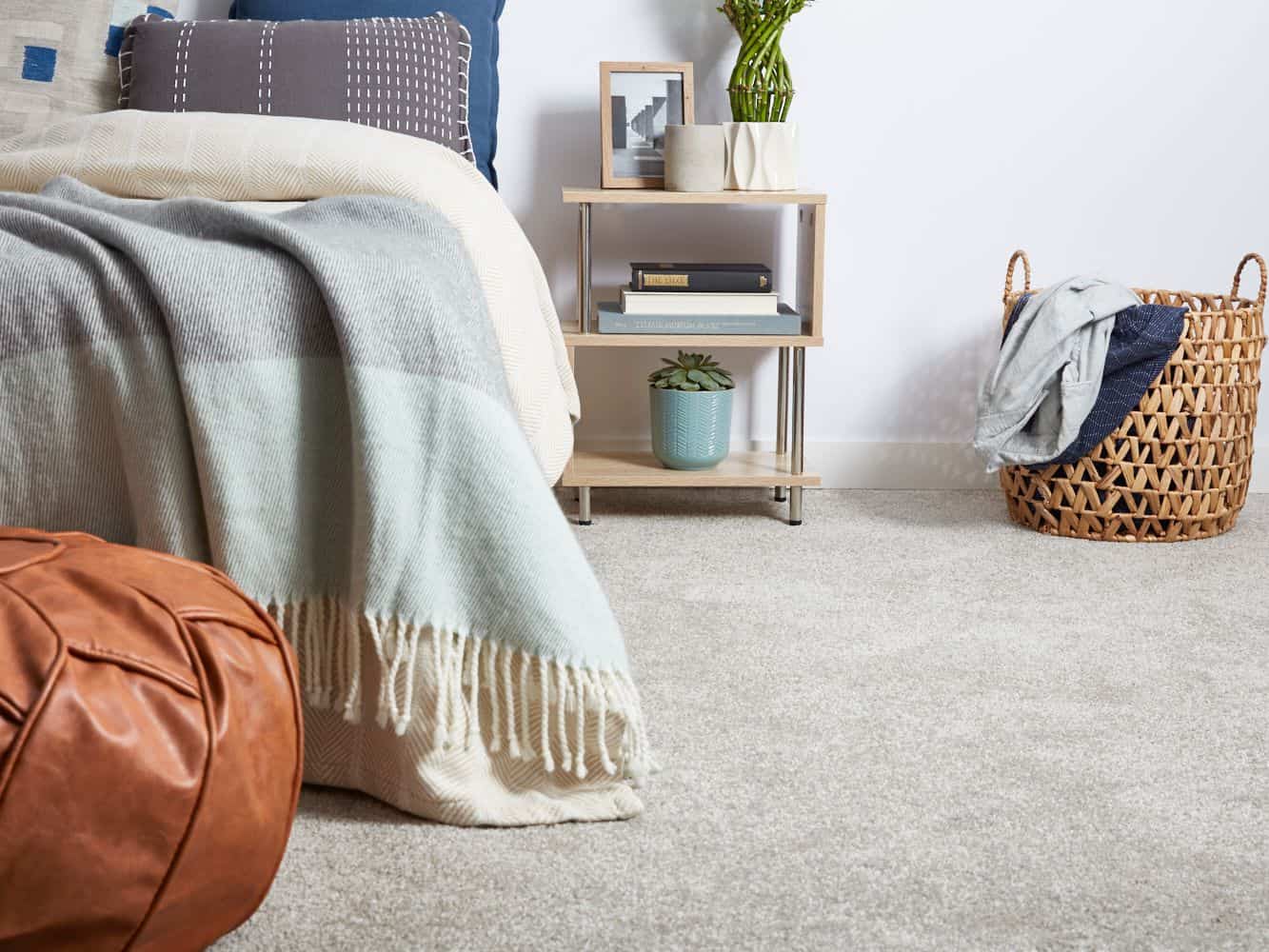It's difficult to get out of bed in the morning with cold bedroom floors. Putting down an area rug large enough to provide your feet a smooth landing on those early mornings makes it simpler to get out of bed.
Proper rug placement may bring color, texture, and pattern to your space while also increasing the room's comfort and adding interest to an otherwise restrained color scheme. We've made it easier with six-bedroom rug placement ideas and a guide to the perfect rug for your bedroom.
Bedroom Rug Placement Ideas
1. Under the Bed
In the bedroom, the most frequent location for an area rug is beneath the bed, where it anchors the room's largest piece of furniture. If your bed is flanked by nightstands, consider whether you want the rug to go below them all the way to the headboard or stop just before the front legs of the nightstands.
Running the rug all the way to the end of your headboard allows you to step out of bed with the rug underfoot, instantly generating a sense of coziness. This is a great way to start any morning and a relaxing way to conclude any evening.

Image Source: whitneyhyggehome.com
It's advisable to show the rug perpendicular to the bed frame in this configuration so that there's plenty of comfort on both sides and at the foot of the bed. Keep your rug larger than 12 feet by 9 feet for a king-size bed—with a mattress slightly larger than 6-by-6-foot.
2. Half-on, Half-off
You can save a little money by choosing a medium-sized rug (think 5-foot by 8-foot, give or take) while still enjoying the aesthetic splendor of a grounded bed frame by pulling the rug under your bed away from the wall, so the nightstands sit squarely on the floor.

Image Source: beckyshea.com
However, before you try this approach, think about the size and shape of your bedroom. If it's rectangular, going with a larger size may be worth it because you'll be able to cover more of the commonly used floor space in front of the bed, keeping your feet warm while saving your existing flooring from wear and strain.
3. Besides the Bed
Runners down each side of your bed are another alternative if you don't want to invest in a rug that will be nearly fully concealed by your bed.
The length and breadth of the rugs are determined by the amount of space available; choose larger runners that run the length of your bed or smaller accent rugs that provide a toasty resting area for chilly feet in the morning.

Image Source: ikea.com
It's often ideal to purchase a custom-length runner so that it fits the area perfectly and has natural starting and finishing spots. A larger rug is usually preferable.
4. Throughout the Room
Here, the size and location of your rug might be influenced by the other furniture in your room, such as dressers and seating spaces. It's great if the rug reaches halfway beneath your dresser. However, if it clears it all the way, it may be too tiny for the space.

Image Source: unsplash.com
When a rug is too tiny, it appears to be lost in the space. A rug with a big enough footprint will allow your furniture to fit comfortably inside its dimensions rather than feeling as if it is set on the rug's edge. Allow a larger rug to extend past the depths of your furniture.
5. End of Bed
The rug is put at the foot of the bed, somewhat tucked below it. This position is ideal if you don't have a lot of space on either side of the bed but plenty at the end.
A rug in this layout should be paired with a bench seat at the end of the bed. Otherwise, the rug would seem strange on its own. Something on top of it is required to ground it.

Image Source: tlcinteriors.com.au
Since a typical rug with a width of around 220cm will work well for the width of a king-sized bed and will still work with a queen-sized bed, this is a really simple and economic plan to execute. There is no need to do some calculations, which is convenient.
6. Doubled up
Layering rugs in a bedroom makes decorative sense, especially if you're more of a maximalist, with unique forms, complimentary patterns, and contrasting textures.

Image Source: apartmenttherapy.com
Start with a large rug layout such as half on, half off layouts, then layer on a smaller rug layout to complete the effect. If you're unsure, lay down a tiny sheepskin rug as a top layer.
Bedroom Rug Placement Guide- Choosing Bedroom Rugs
There are factors to bear in mind when it comes to bedrooms rugs for a quick overall selection.
1. Rug Size
The rug should be about 18 to 24 inches long on either side of a queen-sized bed. This should provide a rug that is 8 to 9 feet long. But when it comes to rug width, they should be around 5 feet broad.
If you want it to reach all the way to the nightstands, it should be at least 9 feet wide. The following are some of the most typical sizes associated with bedroom rugs.
a). 4 x 6
Since a 4-foot by 6-foot rug is so little, it's better to use it as part of a set. It's also suitable for smaller areas. This size rug is best used as a pair on either side of a queen-size bed rather than directly beneath it.
b). 5 x 6
A rug measuring 5 feet by 6 feet is also small, but it can fit easily beneath a queen-sized bed. Because of its tiny size, this rug is frequently utilized in small places. There are no nightstands or bookcases beside the bed since they would interfere with the vastness of the rug and room.
c). 5 x 8
A 5-foot by 8-foot rug is slightly larger than the rugs indicated above, providing a little more length and a better scale for including nightstands or bedside tables.
This rug can go beneath the bed but not under the nightstands because of its shorter 5-foot width. This is still considered a small to medium-sized item. The price of a rug is heavily influenced by its size.
d). 6 x 9
Moving on to the medium-sized rugs. A six-foot-by-nine-foot rug is ideal for medium-sized rooms and queen-sized beds in particular. The room is large enough to accommodate two nightstands, but the rug isn't wide enough to accommodate them.
e). 7 x 10
A 7-foot-by-10-foot rug is on the larger side of the rug scale and is the largest size advised for use beneath a queen-sized bed. This has the ideal amount of surplus on both sides for comfort when entering and exiting the bed.
f). 8 x 10
Although an 8-foot-by-10-foot bed is too large for a queen, it can still be used in a larger room. With this size, you have two options: lay the rug under both nightstands and the bed, or leave a quarter of the bed without a rug underneath.
g). 9 by 12
A 9-foot-by-12-foot rug is large, and it's suitable for scenarios where the flooring is less than the immediate goal and needs to be covered. These are only suitable for big rooms.
2. The Shape of Rug
a). Runner
Runners are often positioned on either side of the bed and/or at the end of the bed because they are long and narrow. These are ideal for locations with limited space and a limited budget. These aren't tucked away under the bed.
b). Square
Since square rugs do not fit proportionally with the length of a bed, they are rarely used in bedrooms. They are appropriate in larger rooms when the square can be expanded to accommodate them.
c). Rectangle
Rectangle rugs are the most frequent in bedrooms, especially queen-sized bedrooms. Rectangular rugs are typically placed perpendicular to the bed to allow greater room to walk on the rug.
d). Round
Round rugs are ideal for smaller rooms because they may fill up the necessary area under a bed while leaving the rest of the room open. These should be positioned in the middle of the bed and should be no more than one foot longer than the bed.
3. Material
a). Wool
Wool rugs are currently in high demand in interior design stores, which comes as no surprise. Due to the material's natural robustness and color retention, wool bedroom rugs are perfect for high-traffic locations such as the living room. If properly cared for, a good quality wool rug may last for decades.
A wool area rug may give warmth to your home in the fall and winter. Keep in mind, though, that wool can absorb up to 30% of its weight in moisture. If you live in a humid environment, you should inspect your wool bedroom rug on a regular basis for weird odors and mildew or mold symptoms.
b). Natural Fibers
Designers love natural fiber carpets like sisal, jute, and seagrass because of their effortlessly fashionable aesthetic and warm, organic feel. When it comes to summer bedroom designs, a natural fiber rug is a must-have.
Sisal and seagrass are popular in high-traffic areas because they are exceedingly resilient. Despite its lack of resilience, jute plants are soaked and peeled before being spun, resulting in a fabric that is as soft as wool. A jute rug will add an earthy feel to any room, making it perfect for a guest or master bedroom.
c). Synthetic Fabric Rugs
If durability is important to you, or if you want bedroom area rugs that can be used both indoors and out, search for patterns made of nylon and polypropylene. These stain- and fade-resistant synthetic textiles are a wonderful alternative for families with small children and pets.
Mildew and moisture resistance is also a feature of nylon and polypropylene. This is great news for anybody thinking about installing a beautiful area rug in a bathroom or other high-humidity location.
Frequently Asked Questions on Bedroom Rug Placement
1. How do I put two area rugs in the bedroom?
- Mix carpets with different textures to add visual appeal.
- Play around with the scale of patterned elements.
- If you're unsure, stick to carpets that are in the same color family.
- If you would like to make a statement, pair two completely distinct styles together.
- If you have to, use the same rug twice.
2. Can a rug be too big for a room?
The size of an area rug can have a significant impact on the overall look of a room. A rug that is very tiny for your space might make the room feel cold and claustrophobic. A rug that is too huge for the space can actually make it feel smaller.
3. How do you coordinate a rug and bedding?
Colors from the bed, chair, or bed bench, as well as wall art or window coverings, are used to tie the room together. Matching area rugs with bedding, accent pillows, and the huge pillows that rest against the headboard produce a harmonious appearance if you wish to strengthen or add a new color scheme.
4. Where should a rug be placed in a bedroom?
In the bedroom, the most frequent location for an area rug is beneath the bed, where it anchors the room's largest piece of furniture. If your bed is flanked by nightstands, consider whether you want the rug to go below them all the way to the headboard or stop just before the front legs of the nightstands.















